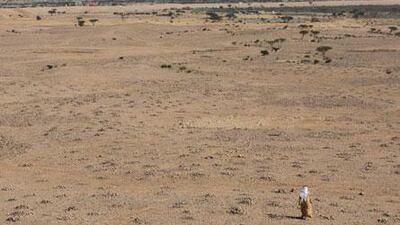On the empty plain below Jebel Hafeet lie clusters of fist-sized rocks whose origins remain a mystery. Theories range from them being representions of the night sky created by ancient tribes to random piles created during oil prospecting in the area. Al AIN // From up close, they look like stones scattered about in a haphazard fashion. But then, as one starts to climb the eastern slope of Jebel Hafeet and looks back, the perspective of distance reveals something strange. The stones are, in fact, grouped in shallow piles that form a mysterious mosaic across the flat plain fringing the mountain.
No one knows how or why the rocks were grouped in this way, says Hasan al Naboodah, a history professor at UAE University as he picks his way across the rough terrain to reach the rocks in his four-by-four. "This mountain and the areas around it carry many stories, most of them untold and lost, like the story of these piles of rocks," he says. Over an area of approximately 10,000 square metres there are dozens of piles, each made from fist-sized stones.
Some are grouped together to form low, circular pyramids, positioned at almost equal distance from each other. Others are arranged into parallel rectangular shapes. In addition to stones, some of the piles have pieces of coral. Seen from a height, the overall effect is of a geometric floral design. "There are many theories about these piles, some more mystical, and others less romantic," says Prof al Naboodah.
"Given their careful design and wide span of the terrain, they could have been aligned with the stars, as the stars were used by our ancestral tribes for geographical landmarks and for marking down the seasons." Indeed, it is tempting to read the patterns as constellations reproduced in stone by human hands on the desert floor. Similar formations of rock piles can be seen in the Al Madam area, south of Al Dhaid in Sharjah, a wide plain where the remains of a major Iron Age mud-brick settlement were discovered in the 1980s.
The Jebel Hafeet stones lie not far from an important and possibly related archaeological finding. Around 20km to the southeast of the mountain stand some 600 dome-shaped tombs, dating from 3200-2800BC. About 100 of these have been excavated, uncovering painted pottery that proved trading links between the inhabitants of the area and the Sumerian civilisation of Mesopotamia. These tombs are also believed to have been connected to an ancient cult that worshipped a Sun god.
Fifty kilometres north of Jebel Hafeet lies another important find, the Qatarrah tomb, excavated in the 1970s. A long, narrow grave with a protruding rocky exterior, similar to others discovered in the 1980s in the Shimal area of Ras al Khaimah, the Qatarrah tomb became one of the first of the second millennium BC to be excavated in the Emirates. Among the most notable finds was a gold ornament depicting a double-headed animal, thought to have been worn as a large medallion in a necklace.
"In pre-Islam time, often places of worship and any rituals related to prayers included round figures and objects that people would rotate around and make prayers and sacrifices to their gods," says Prof al Naboodah. Until recently, he says, "people of the area believed this mountain to be cursed, and home to jinn, and so rarely would people come and explore here and document what they have seen."
Another factor that has prevented extensive exploration is that the piles are close to the Omani border, in an area virtually off limits to random visitors or tourists. Even people from Mezyad, the closest village to the piles of rock, say they do not know much about the rocks, which as an everyday part of the landscape now pass virtually unseen. The elders, says Prof al Naboodah, take little notice of them and regard them as just a "part of nature".
"It is a shame as the young don't know much about the historical sites here and the natural history of their homes," he says. Websites are dedicated to the rocks, with some photographs on Google Earth adding to speculation about their mysterious origins. Actually, says Prof al Naboodah, there are more down-to-earth explanations for the piles. Perhaps the least romantic is the one related by a retired army officer who told him he had witnessed their formation: they had been created during the search for oil in the area in the 1950s.
It was, he said, "a wide search and used a lot of manpower, and then it was forgotten". The drabness of this theory is matched by another that circulates among the residents of Mezyad. This holds that the piles were created to be loaded onto lorries and sold to contractors for crushing and use in construction. Prof al Naboodah is not convinced: "Just a pile of left-over rocks? I don't think so. "Who would go to so much trouble to get them so nicely organised just for construction? It is hard to believe that something so trivial could be behind these beautifully arranged piles."
Now, with the future of these piles under threat, the truth of their past may never be known. Many of the formations are disappearing as the plain is being cleared to make way for construction. For his part, Prof al Naboodah offers no theory for the stone piles. "They could have been put together several hundred years ago, or simply a few decades ago, depending on which story you want to believe," he says.
Regardless of who was responsible, the rocks "add a special touch to this harsh terrain". But, sadly, one that is in danger of vanishing. rghazal@thenational.ae

